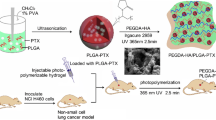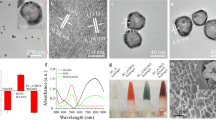Abstract
Pancreatic cancer is one of the most devastating cancers with poor prognosis and no significant change in the survival rate over the past decades. Localized targeted drug delivery through interventional endoscopic ultrasonography-guided fine-needle injection (EUS-FNI) is an attractive and minimally invasive strategy for inoperable pancreatic cancer. An injectable in-situ formed long-lasting drug delivery system is a promising alternative for the localized treatment of pancreatic cancer via EUS-FNI. Here, a biodegradable thermo-sensitive copolymer hydrogel for the co-delivery of anticancer agents gemcitabine (GEM) and cis-platinum (DDP) was developed. This hydrogel is a free flowable liquid at room temperature that changes into a semi-solid hydrogel following injection in response to the physiological temperature. Both in vitro and in vivo drug release behaviors indicate sustained drug release of this delivery system. Synergistic cellular proliferation inhibition and desirable apoptosis promotion have been found when pancreatic cancer Bxpc-3 cells were co-cultured with this GEM-DDP/hydrogel system. After a single intratumoral injection, the dual-drug loaded hydrogel formulation exhibited superior anti-tumor efficacy and minimized systemic side effect on pancreatic cancer xenograft mouse model in comparison to the intravenously injected free GEM and DDP combination. In addition, a strong synergistic therapeutic effect of the GEM-DDP/hydrogel system against pancreatic cancer has been found in vitro and in vivo compared to the single-drug loaded hydrogel composites. The obtained findings suggest this developed thermo-sensitive copolymer hydrogel system as a potential universal carrier for the localized targeted delivery of multi-drugs, for use in a variety of inoperable solid tumors.

Similar content being viewed by others
References
Pai, M.; Spalding, D. Pancreatic cancer. Medicine 2015, 43, 329–333.
Eckel, F.; Schneider, G.; Schmid, R. M. Pancreatic cancer: A review of recent advances. Expert Opin. Investig. Drugs 2006, 15, 1395–1410.
Yang, C. B.; Chan, K. K.; Lin, W. J.; Soehartono, A. M.; Lin, G. M.; Toh, H.; Yoon, H. S.; Chen, C. K.; Yong, K. T. Biodegradable nanocarriers for small interfering ribonucleic acid (siRNA) co-delivery strategy increase the chemosensitivity of pancreatic cancer cells to gemcitabine. Nano Res. 2017, 10, 3049–3067.
Rozengurt, E.; Sinnett-Smith, J.; Eibl, G. Yes-associated protein (YAP) in pancreatic cancer: At the epicenter of a targetable signaling network associated with patient survival. Signal Transduct. Target Ther. 2018, 3, 11.
Gresham, G. K.; Wells, G. A.; Gill, S.; Cameron, C.; Jonker, D. J. Chemotherapy regimens for advanced pancreatic cancer: A systematic review and network meta-analysis. BMC Cancer 2014, 14, 471.
Lee, H. S.; Park, S. W. Systemic chemotherapy in advanced pancreatic cancer. Gut Liver 2016, 10, 340–347.
Liu, L.; Xiong, X. Y.; Shen, M.; Ru, D.; Gao, P.; Zhang, X. Y.; Huang, C.; Sun Y.; Li, H.; Duan, Y. R. Co-delivery of triptolide and curcumin for ovarian cancer targeting therapy via mPEG-DPPE/CaP nanoparticle. J. Biomed. Nanotechnol. 2018, 14, 1761–1772.
Provenzano, P. P.; Cuevas, C.; Chang, A. E.; Goel, V. K.; Von Hoff, D. D.; Hingorani, S. R. Enzymatic targeting of the stroma ablates physical barriers to treatment of pancreatic ductal adenocarcinoma. Cancer Cell 2012, 21, 418–429.
Feig, C.; Gopinathan, A.; Neesse, A.; Chan, D. S.; Cook, N.; Tuveson, D. A. The pancreas cancer microenvironment. Clin. Cancer Res. 2012, 18, 4266–4276.
Vandana, M.; Sahoo, S. K. Long circulation and cytotoxicity of PEGylated gemcitabine and its potential for the treatment of pancreatic cancer. Biomaterials 2010, 31, 9340–9356.
Khan, S.; Chauhan, N.; Yallapu, M. M.; Ebeling, M. C.; Balakrishna, S.; Ellis, R. T.; Thompson, P. A.; Balabathula, P.; Behrman, S. W.; Zafar, N. et al. Nanoparticle formulation of ormeloxifene for pancreatic cancer. Biomaterials 2015, 53, 731–743.
Jiang, L.; Ding, Y.; Xue, X. L.; Zhou, S. S.; Li, C.; Zhang, X. K.; Jiang, X. Q. Entrapping multifunctional dendritic nanoparticles into a hydrogel for local therapeutic delivery and synergetic immunochemotherapy. Nano Res. 2018, 11, 6062–6073.
Song, Q. Q.; Zhang, R. S.; Lei, L.; Li, X. Y. Self-assembly of succinated paclitaxel into supramolecular hydrogel for local cancer chemotherapy. J. Biomed. Nanotechnol. 2018, 14, 1471–1476.
Bilalis, P.; Skoulas, D.; Karatzas, A.; Marakis, J.; Stamogiannos, A.; Tsimblouli, C.; Sereti, E.; Stratikos, E.; Dimas, K.; Vlassopoulos, D. et al. Self-healing pH-and enzyme stimuli-responsive hydrogels for targeted delivery of gemcitabine to treat pancreatic cancer. Biomacromolecules 2018, 19, 3840–3852.
Indolfi, L.; Ligorio, M.; Ting, D. T.; Xega, K.; Tzafriri, A. R.; Bersani, F.; Aceto, N.; Thapar, V.; Fuchs, B. C.; Deshpande, V. et al. A tunable delivery platform to provide local chemotherapy for pancreatic ductal adenocarcinoma. Biomaterials 2016, 93, 71–82.
Yang, B. W.; Gu, Z.; Chen, Y. Nanomedicine-augmented cancer-localized treatment by 3D theranostic implants. J. Biomed. Nanotechnol. 2017, 13, 871–890.
Yang, W. J.; Zhou, P.; Liang, L. J.; Cao, Y. P.; Qiao, J. Q.; Li, X. H.; Teng, Z. G.; Wang, L. H. Nanogel-incorporated injectable hydrogel for synergistic therapy based on sequential local delivery of combretastatin-A4 phosphate (CA4P) and doxorubicin (DOX). ACS Appl. Mater. Interfaces 2018, 10, 18560–18573.
Norouzi, M.; Nazari, B.; Miller, D. W. Injectable hydrogel-based drug delivery systems for local cancer therapy. Drug Discov. Today 2016, 21, 1835–1849.
Fakhari, A.; Subramony, J. A. Engineered in-situ depot-forming hydrogels for intratumoral drug delivery. J. Control. Release 2015, 220, 465–475.
Jeong, B.; Kim, S. W.; Bae, Y. H. Thermosensitive sol-gel reversible hydrogels. Adv. Drug Deliv. Rev. 2012, 64, 154–162.
Gong, C.; Qi, T.; Wei, X.; Qu, Y.; Wu, Q.; Luo, F.; Qian, Z. Thermosensitive polymeric hydrogels as drug delivery systems. Curr. Med. Chem. 2013, 20, 79–94.
Shen, W. J.; Chen, X. B.; Luan, J. B.; Wang, D. N.; Yu, L.; Ding, J. D. Sustained codelivery of cisplatin and paclitaxel via an injectable prodrug hydrogel for ovarian cancer treatment. ACS Appl. Mater. Interfaces 2017, 9, 40031–40046.
Du, C.; Wang, Y. Y.; Shi, K.; Zhao, M. Y.; Tu, L.; Yu, Y.; Li, Z.; Luo, F.; Qian, Z. Y. Efficient suppression of liver metastasis cancers by paclitaxel loaded nanoparticles in PDLLA-PEG-PDLLA thermosensitive hydrogel composites. J. Biomed. Nanotechnol. 2017, 13, 1545–1556.
Kim, D. Y.; Kwon, D. Y.; Kwon, J. S.; Park, J. H.; Park, S. H.; Oh, H. J.; Kim, J. H.; Min, B. H.; Park, K.; Kim, M. S. Synergistic anti-tumor activity through combinational intratumoral injection of an in-situ injectable drug depot. Biomaterials 2016, 85, 232–245.
Takakura, K.; Koido, S. Direct therapeutic intervention for advanced pancreatic cancer. World J. Clin. Oncol. 2015, 6, 216–219.
Neesse, A.; Michl, P.; Frese, K. K.; Feig, C.; Cook, N.; Jacobetz, M. A.; Lolkema, M. P.; Buchholz, M.; Olive, K. P.; Gress, T. M. et al. Stromal biology and therapy in pancreatic cancer. Gut 2011, 60, 861–868.
Hilbig, A.; Oettle, H. Gemcitabine in the treatment of metastatic pancreatic cancer. Expert Rev. Anticancer Ther. 2008, 8, 511–523.
Dai, J. T.; Zhang, Y.; Li, H. C.; Deng, Y. H.; Elzatahry, A. A.; Alghamdi, A.; Fu, D. L.; Jiang, Y. J.; Zhao, D. Y. Enhancement of gemcitabine against pancreatic cancer by loading in mesoporous silica vesicles. Chin Chem. Lett. 2017, 28, 531–536.
Poon, C.; He, C. B.; Liu, D. M.; Lu, K. D.; Lin, W. B. Self-assembled nanoscale coordination polymers carrying oxaliplatin and gemcitabine for synergistic combination therapy of pancreatic cancer. J. Control. Release 2015, 201, 90–99.
Mukherjee, S.; Hurt, C. N.; Bridgewater, J.; Falk, S.; Cummins, S.; Wasan, H.; Crosby, T.; Jephcott, C.; Roy, R.; Radhakrishna, G. et al. Gemcitabine-based or capecitabine-based chemoradiotherapy for locally advanced pancreatic cancer (SCALOP): A multicentre, randomised, phase 2 trial. Lancet Oncol. 2013, 14, 317–326.
Philip, P. A. Gemcitabine and platinum combinations in pancreatic cancer. Cancer 2002, 95, 908–911.
Symon, Z.; Davis, M.; McGinn, C. J.; Zalupski, M. M.; Lawrence, T. S. Concurrent chemoradiotherapy with gemcitabine and cisplatin for pancreatic cancer: From the laboratory to the clinic. Int. J. Radiat. Oncol. Biol. Phys. 2002, 53, 140–145.
Colucci, G.; Labianca, R.; Di Costanzo, F.; Gebbia, V.; Cartenì, G.; Massidda, B.; Dapretto, E.; Manzione, L.; Piazza, E.; Sannicolò, M. et al. Randomized phase III trial of gemcitabine plus cisplatin compared with single-agent gemcitabine as first-line treatment of patients with advanced pancreatic cancer: The GIP-1 study. J. Clin. Oncol. 2010, 28, 1645–1651.
Miao, L.; Guo, S. T.; Zhang, J.; Kim, W. Y.; Huang, L. Nanoparticles with precise ratiometric co-loading and co-delivery of gemcitabine monophosphate and cisplatin for treatment of bladder cancer. Adv. Funct. Mater. 2014, 24, 6601–6611.
Xiong, H. Q.; Carr, K.; Abbruzzese, J. L. Cytotoxic chemotherapy for pancreatic cancer. Drugs 2006, 66, 1059–1072.
Wei, L. Y.; Chen, J. J.; Zhao, S. H.; Ding, J. X.; Chen, X. S. Thermo-sensitive polypeptide hydrogel for locally sequential delivery of two-pronged antitumor drugs. Acta Biomater. 2017, 58, 44–53.
Shi, K.; Wang, Y. L.; Qu, Y.; Liao, J. F.; Chu, B. Y.; Zhang, H. P.; Luo, F.; Qian, Z. Y. Synthesis, characterization, and application of reversible PDLLA-PEGPDLLA copolymer thermogels in vitro and in vivo. Sci. Rep. 2016, 6, 19077.
Chou, T. C. Drug combination studies and their synergy quantification using the Chou-Talalay method. Cancer Res, 2010, 70, 440–446.
Cui, S. Q.; Yu, L.; Ding, J. D. Semi-bald micelles and corresponding percolated micelle networks of thermogels. Macromolecules 2018, 51, 6405–6420.
Wang, W. W.; Song, H. J.; Zhang, J.; Li, P.; Li, C.; Wang, C.; Kong, D. L.; Zhao, Q. An injectable, thermosensitive and multicompartment hydrogel for simultaneous encapsulation and independent release of a drug cocktail as an effective combination therapy platform. J. Control. Release 2015, 203, 57–66.
Besançon, O. G.; Tytgat, G. A. M.; Meinsma, R.; Leen, R.; Hoebink, J.; Kalayda, G. V.; Jaehde, U.; Caron, H. N.; van Kuilenburg, A. B. P. Synergistic interaction between cisplatin and gemcitabine in neuroblastoma cell lines and multicellular tumor spheroids. Cancer Lett. 2012, 319, 23–30.
Moufarij, M. A.; Phillips, D. R.; Cullinane, C. Gemcitabine potentiates cisplatin cytotoxicity and inhibits repair of cisplatin-DNA damage in ovarian cancer cell lines. Mol. Pharmacol. 2003, 63, 862–869.
Crul, M.; van Waardenburg, R. C. A. M.; Bocxe, S.; van Eijndhoven, M. A. J.; Pluim, D.; Beijnen, J. H.; Schellens, J. H. M. DNA repair mechanisms involved in gemcitabine cytotoxicity and in the interaction between gemcitabine and cisplatin. Biochem. Pharmacol. 2003, 65, 275–282.
Acknowledgements
We gratefully acknowledge financial support from the National Natural Science Fund for Distinguished Young Scholars (No. 31525009), the National Natural Science Foundation of China (Nos. 31800797 and 31771096), the National Key Research and Development Program of China (No. 2017YFC1103502), the China Postdoctoral Science Foundation funded project (No. 2018M631094), the Postdoctoral Innovation Talents Support Program (No. BX20180207), and 1·3·5 project for disciplines of excellence, West China Hospital, Sichuan University.
Author information
Authors and Affiliations
Corresponding author
Electronic supplementary material
12274_2019_2342_MOESM1_ESM.pdf
Sustained co-delivery of gemcitabine and cis-platinum via biodegradable thermo-sensitive hydrogel for synergistic combination therapy of pancreatic cancer
Rights and permissions
About this article
Cite this article
Shi, K., Xue, B., Jia, Y. et al. Sustained co-delivery of gemcitabine and cis-platinum via biodegradable thermo-sensitive hydrogel for synergistic combination therapy of pancreatic cancer. Nano Res. 12, 1389–1399 (2019). https://doi.org/10.1007/s12274-019-2342-7
Received:
Revised:
Accepted:
Published:
Issue Date:
DOI: https://doi.org/10.1007/s12274-019-2342-7




